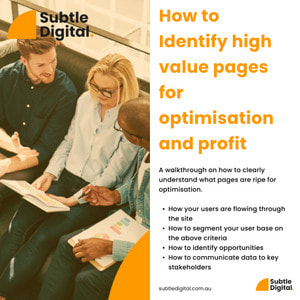We've compiled a guide on how to identify high-value pages on your site that need just a little more tweaks to start performing to the best of their ability. Lets dive in.
Table of Contents
- 1. Analytics metrics in GA to watch (Start here)
- 2. User split
- 3. Analyse Segments
- 4. Identify optimization opportunities
- 5. Compile interesting data for stakeholders
- 6. Conclusion (and profit)
1. Analytics metrics in Google Analytics to watch
- Sessions: Very similar to users. The key difference is that a single user can have multiple sessions. For best practice it’s better to use this metric rather than users, as it tells how many sessions were observed that went to a particular page and what metrics are associated with them.
- Bounce: A bounce is determine when a user enters and exists the site on same page has no interaction and exits within 30 seconds. Key note is that bounce rates can be misleading. Firstly identify how bounces are being referenced and that no interactions are skewing data. Live chat widgets can throw the data out.
- Exit Page: The page from which the user exits the site. It’s a great way to identify why people left — obviously without context you won’t get the full picture. Caveats here; exits rates will be high on order complete pages (Obviously) and blog posts (If there’s no CTA within the page). For pages such as category, product and cart; if these are high, I would be classing them as areas of concern.
- Landing Page: The page on which a user starts their journey. It’s a great way to understand where users are landing on your site. Tip: Segment by source!
- Pages Per Session: How many pages a user views in each session. Great way to identify how engaged users are within the site. For example a user can go through multiple pages in a single session (Obviously they’re engaged) or they’re looking at multiple pages because they’re unsure what they’re looking for (Not good). Tip: look at the exit pages. Engaged users will leave further down the marketing funnel, while confused users will leave at random pages.
- Goal Completion: How you track and measure your goal progress. e.g. how many checkouts or form submissions. Measure this against your own expectations.
- Search Queries: What are your users searching for? If enabled. Great to understand intent and whether users are using search onsite. Tip: categories all search queries and look for common themes or misspellings to identify new content pages or even product/promotion ideas
- Scroll Depth Metrics: How deep a user has scrolled on a page. It showcases average level of intent and interest in the content on page. Tip: Keep important content above the fold otherwise use this as a measurement tool to understand audience interest.
- Page Value: The $$ associated with a particular page or pages. For pages with a higher $$, the more importance it has. Tip: This needs to be setup properly as this is a really important page. You can use this to optimise high-value pages to boost your ROI!
2. User split
Split your users by device, device, visitor type, persona, status, source, entry point and behavior based on the following segmentation.
- Desktop or mobile.remember 80% of traffic is from mobile devices thesedays
- New or repeat visitors. Some great insights here
- Specific categories or personas, like people shopping for shoes or handbags, or small business or enterprise.
- Logged in users or not logged in users. How are they different?
- Converters or non-converters. What makes them different?
- Source: paid advertising, organic, or direct traffic. It can also be worth comparing different campaigns on a specific page.
- Landing page Are you running specific landing pages for campaigns?
- Events: for example, used a filter or didn’t use filter.
3. Analyse Segments
Look at segmented reports and flag any problem segments
Acquisition reporting
Channels: check that these are tagged in a consistent way. For example, some brands interchange source and medium, as long as you're all using the same term, it will be fine. If not, you're going to get conflicting data.
Source: where the traffic came from. For example, Google, Bing, Facebook, third party referrer. While you’re here, you can flag things like Facebook campaigns aren’t driving as much revenue as Google campaigns. Include context about the type of campaign. For example, a brand campaign might understandably draw few conversions – the important metrics might be time on site or pages/session. Additional segments (desktop vs. mobile, etc.) can be helpful in insight generation here
Medium:
Category of the Source. For example, paid search, or social. Further segment source by looking at the medium. Brand campaigns tend to be categorized within the medium more easily, too.
Behavior reporting:
Landing Pages View: Identify top entry pages and segment to understand who is entering where, and at what levels. Then look at what do they do after that.
Exit Pages view: Identify top exit pages. Exclude pages that you don’t care about – for example, a thank-you page is usually an understandable and acceptable exit point. Segment to understand who is exiting, where, and after how long.
All Pages view: Identify top trafficked pages, based on sessions and pageviews. Segment to understand who is going where. Look at bounces on pages. Segment to understand who is bouncing the most. For example, it’s common for paid search to have higher bounce rates than direct and organic traffic. Look at time on page. Segment to understand who is spending more or less time on specific pages – high time on site pages could be higher value pages.
Speed view: flag pages that are slower than average to load. side note: most brands only focus on the home page. This is a big no-no. Segment by page, browser, and country. Test problematic pages on PageSpeed Insights to find tactical items to address. If you can’t see what’s going on, flag some slow loading pages with your development team to see if they can help figure out why those pages are loading slowly.
Site Search view: validate that Site Search is installed correctly and tracking queries. Look at top queries, and conversion rates based on the top queries.
Conversions reporting:
Conversion goals: Focus on tracking which pages drive higher conversion goals. Make sure you understand what is being tracked, and how.
Abandoned cart rate: look at the exit rate on the cart page, and corroborate that metric with the abandoned cart rates.
Revenue per user or visitor: understand what revenue is, and how it’s tracked and calculated. There may be a backend system unrelated to analytics which is the master revenue data, and the revenue data may not be collected retroactively in google analytics. For ecommerce, make sure the revenue accounts for things like returns and upsells.
4. Identify optimization opportunities
Identify pages with:
Top traffic: See if there are any metrics which stand out, like time on site, add to cart rate, or exit rate. Pages with high traffic and bad engagement have the biggest ROI for testing and optimization. Segment to find the biggest source of traffic to those pages. Use previous and next page paths to understand how users came to this page, and where they went next.
Lowest engagement: Like time on site and high bounce rate. Segment to find the biggest offenders dragging down the average.
Highest page value: Segment to identify which segments draw the highest value on those pages.
Highest exit rate: Segment on traffic source and device.
Top custom events: Segment on audiences. For ecommerce, see which products get added to cart the most, and understand what % of those convert. For example, a lot of people might add certain products to their cart but not go through with the purchase, which could provide interesting insights.
Look at high-risk accounts: Those that are most likely to churn soon. Identify crucial actions or features that contribute to user retention, and analyze users who used it 0 or 1 times in the last 30 days. This is hard to do with current data laws, unless you have zero-party data elements on site
Analyze new compared to returning users.
5. Compile interesting data for stakeholders.
After running the above through the motions, identify any significant issues that stand out (wins) and communicate it with key stakeholders.
Your main objective is to highlight WHY the data is important or interesting and what the next steps will be.
6. Conclusion (and profit)
Putting this into practice:
- Run through the above.
- Analyse the data
- Compile the winners (or losers) and segment for the lowest hanging fruit, or items that will have the potential for the greatest ROI. 3 - 5 issues max (pending on the complexity)
-
Build out your reasoning:
- A particular landing page has a very high bounce rate (out of the ordinary), after further analysis you concluded that META segment of traffic is performing badly and bringing down the average.
- You uncover that the ads displayed are vastly different to the site design and messaging.
- You come to the conclusion that your visitors are getting confused with what they're seeing in the ads vs onsite and are leaving in droves (It explains the high bounce rate.)
- Compile your findings (up to 5 components to fix) -- Along with your data points -- into a google slide/powerpoint and communicate your findings, timeframes and next steps to the relevant stakeholders.

